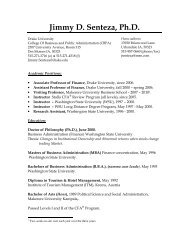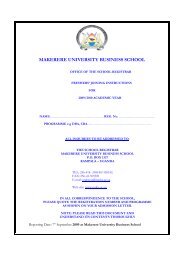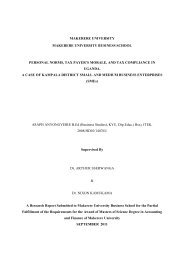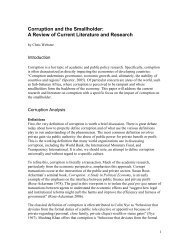13th Annual International Management Conference Proceeding
13th Annual International Management Conference Proceeding
13th Annual International Management Conference Proceeding
You also want an ePaper? Increase the reach of your titles
YUMPU automatically turns print PDFs into web optimized ePapers that Google loves.
Sociologists and organizational theorists have elaborated three highly interrelated dimensions of social<br />
capital: structural capital—the structure of the overall network of relations (Burt, 1992); relational capital—<br />
the kind and quality of an actor’s personal relations (Granovetter, 1992); and cognitive capital—the degree<br />
to which an individual shares a common code and systems of meaning within a community (Nahapiet &<br />
Ghoshal, 1998).<br />
The structural dimension refers to the overall pattern of connections between actors—that is, whom one<br />
reaches (Burt, 1992). Various authors have emphasized the importance of networks for social<br />
entrepreneurship. Structural capital defines the potential or possibilities that the social entrepreneur has to<br />
access information, resources and support. It is important to understand the structural dimension of social<br />
capital, how it can be built, increased and, most importantly, maintained, since it is one of the factors that<br />
will determine whether and to what extent social entrepreneurs are able to solve and alleviate social problems,<br />
and elevate them to the public sphere. The relational dimension of social capital focuses on the quality of<br />
relationships, such as trust, respect and friendliness. There is growing evidence that when trust is built up<br />
between parties, they are more eager to engage in cooperative activity, through which further trust may be<br />
generated (Fukuyama, 1997). The Grameen Bank’s credit delivery system is a good<br />
example. Borrowers are organized into small homogeneous groups, sharing responsibility for loans granted to<br />
other members of their group, and facilitating solidarity, as well as participatory interaction. It is important<br />
to understand how trust is created among the different members of the group, but also how trust between<br />
the members and the Grameen Bank is sustained and downward leveling norms (Portes, 1998).<br />
Consider the characteristic of the Grameen Bank credit delivery system: it enhances solidarity. While<br />
solidarity is generally thought to be positive, in some circumstances it may backfire. Various authors have<br />
emphasized the downside of over embeddedness. For example, Gargiulo and Bernassi (1999) claimed that<br />
strong solidarity within group members may result in over embeddedness, which reduces the flow of new<br />
ideas into the group and can result in parochialism and inertia.<br />
For social entrepreneurs, the social mission is explicit and central. This obviously affects how social<br />
entrepreneurs perceive and assess opportunities. Mission-related impact becomes the central criterion, not<br />
wealth creation. Wealth is just a means to an end for social entrepreneurs.<br />
Therefore, any definition of social entrepreneurship should reflect the need for a substitute for the market<br />
discipline that works for business entrepreneurs. We cannot assume that market discipline will automatically<br />
weed out social ventures that are not effectively and efficiently utilizing resources. The following definition<br />
combines an emphasis on discipline and accountability with the notions of value creation taken from Say,<br />
innovation and change agents from Schumpeter, pursuit of opportunity from Drucker, and resourcefulness<br />
from Stevenson. In brief, this definition can be stated as follows:<br />
Social entrepreneurs play the role of change agents in the social sector, by:<br />
Adopting a mission to create and sustain social value (not just private value),<br />
Recognizing and relentlessly pursuing new opportunities to serve that mission,<br />
Engaging in a process of continuous innovation, adaptation, and learning,<br />
Acting boldly without being limited by resources currently in hand, and<br />
Exhibiting heightened accountability to the constituencies served and for the outcomes created.<br />
This is clearly an “idealized” definition. Social sector leaders will exemplify these characteristics in different<br />
ways and to different degrees. The closer a person gets to satisfying all these conditions, the more that<br />
person fits the model of a social entrepreneur. Those who are more innovative in their work and who create<br />
more significant social improvements will naturally be seen as more entrepreneurial. Those who are truly<br />
Schumpeterian will reform or revolutionize their industries.<br />
Change agents in the social sector: Social entrepreneurs are reformers and revolutionaries, as described by<br />
Schumpeter, but with a social mission. They make fundamental changes in the way things are done in the<br />
social sector. Their visions are bold. They attack the underlying causes of problems, rather than simply<br />
treating symptoms. They often reduce needs rather than just meeting them. They seek to create systemic<br />
66
















